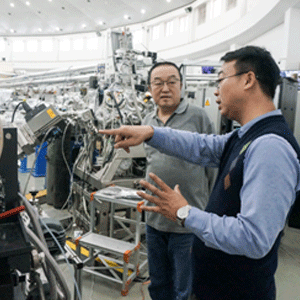Partners launch dedicated synchrotron for student use

TK Sham’s decades at the helm of Canada’s synchrotron science program have yielded a battery of personal and professional triumphs, the latest of which is the inauguration of a fully operational synchrotron beamline in Hefei, China. “This project took root back in 2011 when the president of Soochow University visited Western,” explains Sham; during the visit, the two universities conceived a joint venture called the Soochow Western Centre (SWC) for synchrotron radiation research, with its headquarters at the Chinese university and a hub at Western. Sham, as director, oversaw the commitment of C$2 million from Soochow to construct a new facility starting in 2015. Five years later, the beamline is up and running.
“Synchrotron facilities are unique around the world. Canada has one, the Canadian Light Source in Saskatoon,” says Sham. The relative rarity of these facilities around the world means that they are hotbeds for the fostering of collaborations between international research groups. “When I started graduate studies at Western in the seventies, we were working closely with a group in Wisconsin.” The newly functioning facility in Hefei represents a new opportunity for international mobility of students and ideas between Western and Soochow; already, a joint “2+2” PhD program is underway between the universities. “Having a collaborative facility means that students can spend two years at each university and graduate with a Western degree,” tells Sham. The operational beamline will broaden the opportunities available for Western undergraduate and graduate students to conduct international research.
In addition to advancing materials science capabilities, having a facility at their disposal means an unparalleled training opportunity for Western and Soochow students. “I think the most important thing is that now there is an instrument that can facilitate the training of young people. This instrument will empower Western and Soochow students to take control of the research, from experimental design to execution. Having full agency, rather than borrowing someone else’s technology, makes a world of difference,” says Sham.
 This is the first joint venture of its kind in China and the country’s first synchrotron beamline with significant university participation. The facility uses an accelerator to generate x-rays and a beamline to channel them towards novel materials, such as composite batteries, for analysis at the molecular level. “I am proud of this collaboration as it puts into action the mission of Western University. We are developing a long-term, research and training opportunity with an international partner, and that, to me, is of great value.” While Sham insists he will be retired before the next facility is built in Canada, the SWC co-operation will enable generations of students to push the boundaries of materials science while developing an international network of collaborators.
This is the first joint venture of its kind in China and the country’s first synchrotron beamline with significant university participation. The facility uses an accelerator to generate x-rays and a beamline to channel them towards novel materials, such as composite batteries, for analysis at the molecular level. “I am proud of this collaboration as it puts into action the mission of Western University. We are developing a long-term, research and training opportunity with an international partner, and that, to me, is of great value.” While Sham insists he will be retired before the next facility is built in Canada, the SWC co-operation will enable generations of students to push the boundaries of materials science while developing an international network of collaborators.
Written by Sasha Madhavji

